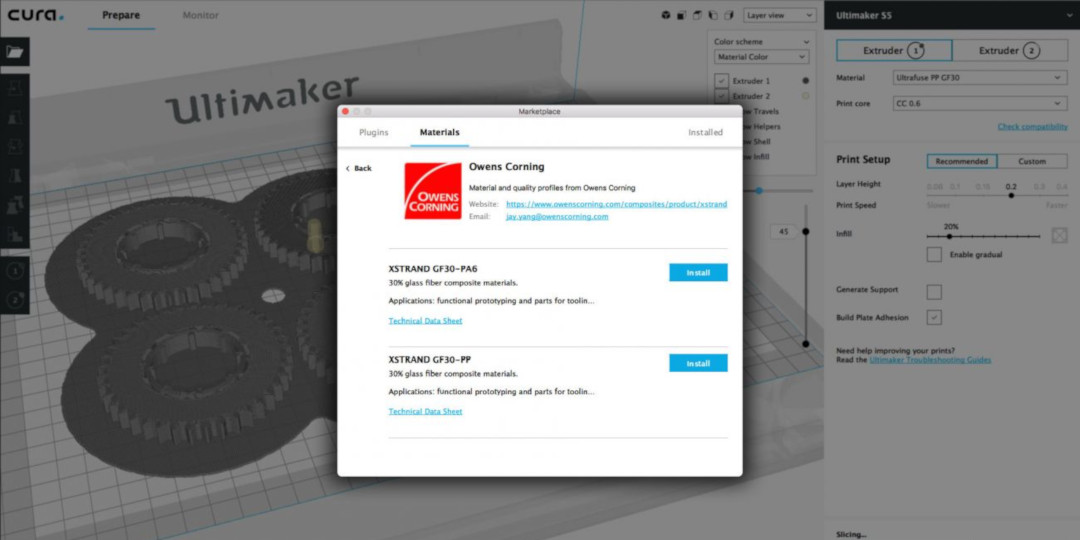To create the perfect 3D print, it’s vital to have access to the right material, but it’s also critical to use the right slicing settings. Preconfigured print profiles in Ultimaker Cura make this job easier for users, but how do we ensure that profiles will deliver high-quality results? Quite simply, we don’t operate alone. Owens Corning, one of the world’s leading manufacturers of fiberglass composites, works with us as part of our material alliance program.
With 3D printing labs both in the US and France, and over 19,000 employees across the globe, Owens Corning is no stranger to cutting-edge technology. Their new material profiles enable Ultimaker Cura users to print with their range of fiberglass composite materials easily.
But what applications does fiberglass reinforced filament unlock, and what should you keep in mind when using it? In our most recent AMA (“ask me anything”) session, we held a public discussion with the material engineers at Owens Corning, where 3D printing enthusiasts were given the chance to ask questions via Twitter or our community forum. Here are a few highlights from the session, where we learned more about their processes and the unique properties of their materials.
GFPA6 or GFPP?
Several people wanted to gain insight into what materials the engineers at Owens Corning would recommend. User @Valcrow asked:
“What are the main factors that would make you choose GFPA6 over GFPP or vice versa?”
Owens Corning answered: “If I’m deciding GFPP or GFPA6, it comes down to size and surface finish. If I’m looking for something with amazing surface finish, I would choose the GFPP. If the part is large or the surface area that is touching the build plate consumes most of the area, I would choose GFPA6 as there are no warping issues. GFPP can be tricky when printing large flat parts”.
Owens Corning materials in the Ultimaker Cura Marketplace
Developing for reliability
Other users were curious to learn more about Owens Corning’s development process. User @Brulti wanted to find out how long the process of creating a new material was, from the initial concept through to the actual product being sold. He also wanted to know how many different iterations the material went through during testing to find the ideal mix, and whether they were using computer simulations or not.
Owens Corning replied: “A new material development requires about six to nine months. We’re not using computer simulations for now”. They then discussed their new XSTRAND™ filament, which is a combination of polymer, fiberglass, and additives. These are mixed together to ensure the right material viscosity for perfect printability and good processability, while also maximizing both mechanical and technical performance. When developing this material, they went through numerous iterations and experimental phases to get it right.
The tensile strength of XSTRAND™ (Nylon and fiberglass)
XSTRAND™ with Nylon and fiberglass is 100 mPa, which – as many of our users might know – is a far higher tensile strength than many other materials. Some of our community were curious about how this was achieved, particularly user @GR5, who asked this:
“Tensile strength of the strongest Nylons I’ve seen is 55 mPa. Glass is typically 50 mPa. So how do you get XSTRAND™ with Nylon and glass to be 100 mPa (my own tests with XSTRAND GF30PA6 yielded 80 mPa which is still >55)? Is it a special glass that is stronger than typical window glass?”
An interesting point indeed. Owens Corning answered: “Glass fibers have a much higher tensile strength than regular glass (200-500 times stronger). Typical value for tensile strength for fiberglass is in the range of 1,900 to 2,000 mPa”.
Learn more about printing abrasive materials
Want to find out more about the session? You can read the rest on our community of 3D printing experts. Thanks to everyone who participated, and to the material engineers at Owens Corning for providing such insightful answers. Find out more about our material alliances in our community thread.
We love hosting AMA sessions, so make sure you hear about the next event by following us on Twitter.
You can learn more about 3D printing abrasive materials with Ultimaker hardware and software via our materials pages.
























